14 September 2021 | Wind is not everything
Despite the favourable wind conditions, after Roeland and Abel, none of the other GPS-tracked spoonbills decided to start migrating south for nearly two weeks. Wind is – perhaps not surprisingly – not the only factor determining whether a spoonbill will depart on migration!
Another factor that plays a role is an animal’s internal calendar which roughly “tells” the animal when to perform which activities (moulting, migrating, breeding) throughout the year. This internal calendar may differ among individuals. In addition, the birds need to get “physically” ready to migrate, by building up sufficient fat reserves, and, in case of juvenile birds, learning to forage for themselves rather than being fed by their parents. Juvenile spoonbills do not migrate together with their parents, so they completely rely on their own foraging skills after departing on migration.
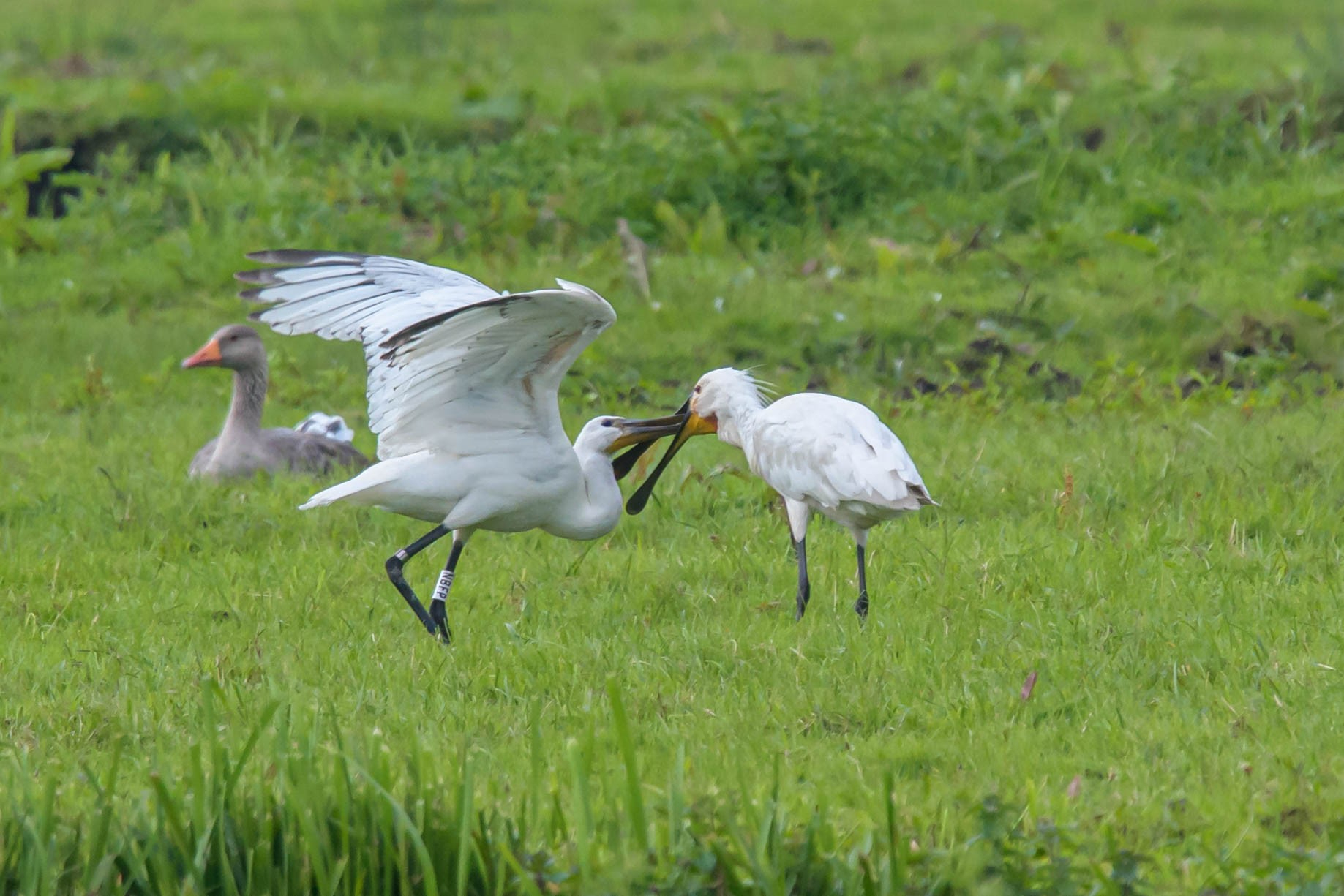
Observations by citizen scientists confirm that at least part of the GPS-tracked juvenile spoonbills are still being fed by their parents long after fledging. Are the early departing juveniles the ones that became independent from their parents relatively quickly? Or the ones that stayed in good quality foraging habitats prior to their departure? We will address this question by combining the data collected by citizen scientists on the foraging success of GPS-tracked juveniles with an analysis of the accelerometer data that is collected by the GPS-trackers themselves. The latter allows us to quantify the proportion of time spent on different activities (e.g., begging, foraging, resting, flying) and may even enable us to distinguish prey ingestions and eventually, foraging success.
Three more departures
After two weeks of little movement, three more birds departed in the past two days! On Sunday evening, Spoonbill Petra departed from Harderbroek, where she had spent the past month. After staying on the Plaat van Walschoorden in the Westerschelde for the night, she took off again in the early morning and had already passed the French border at 10:00h.
Spoonbill Petra was shorty followed by spoonbill Camilla, who departed yesterday morning from the Oostvaardersplassen and flew in one go to Lac de Grand-Lieu in southern Bretagne, where she arrived in the middle of the night at 2:00h. This is a well-known foraging and breeding area for Spoonbills in the Loire-Atlantique.
Spoonbill Harro departed yesterday evening at 19:00h and is currently flying along the coast of Normandie.
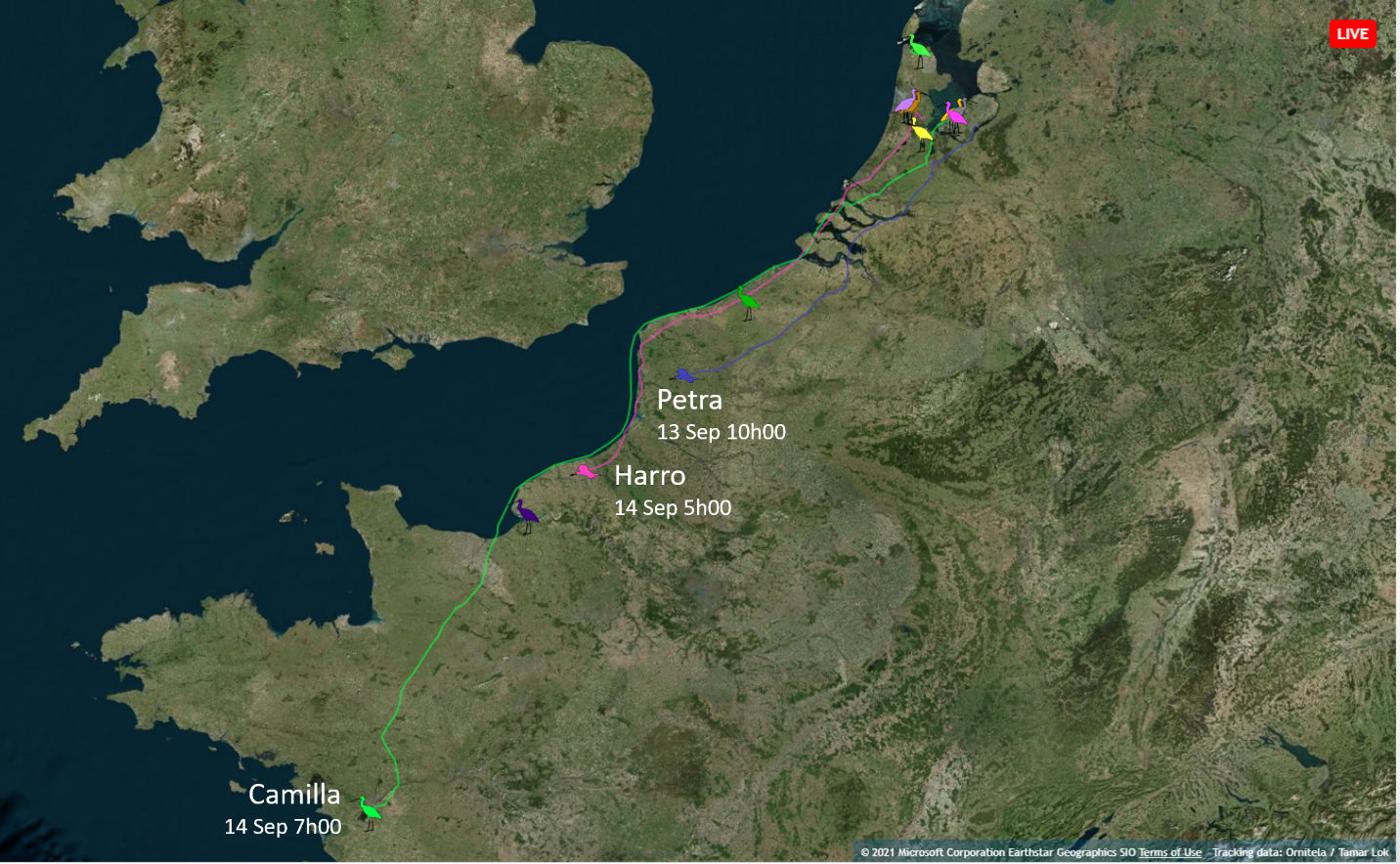
Some sad news
There is also some sad news to report, as two GPS-tracked birds are (likely) no longer with us. Spoonbill Abel disappeared from the map, two days after he arrived in the Embalse de Almendra in Spain. We do not know what happened as his transmitter just went offline from one moment to the other. Some days of silence are normal, as the bird may be in an area with poor GSM coverage, but after a couple of days, it becomes unlikely that the bird is still alive. We therefore fear that Abel is no longer with us. Perhaps his impressive 25-hour non-stop flight (see previous blog) had taken its toll.
The second bird that passed away is Wilco. He didn’t even depart on migration. In contrast to Abel, his transmitter was still working after he died, so we went to the place where the transmitter kept sending signals and found the bird. Wilco had no physical injuries, which could indicate predation or collision, and had a normal bodyweight, indicating that he didn’t die from starvation. The bird will be dissected and analysed to determine its most likely cause of death (e.g. infection, intoxication).
It is always sad to be confronted with the death of animals, especially if they bear a name, but it is part of life. In general, mortality is much higher among juvenile (inexperienced) animals than among adults. In the case of spoonbills, analysis of 75,000 resightings of colour-ringed individuals along the entire flyway learned us that less than half (c. 40%) of the fledged juveniles survive the first year, with the vast majority dying during their first southward migration. In contrast, the annual survival rate of adult spoonbills is much higher, around 80%. Let’s hope that the deaths of the GPS-tracked spoonbills will learn us more about their causes and may help to better protect spoonbills and the habitats that they rely on.
25 August 2021 | Roeland and Abel have the wind in the back
In the past two days, two other GPS-tracked juvenile spoonbills departed on migration, both from the Oostvaardersplassen, where hundreds of spoonbills are still present and preparing for migration.
By Tamar Lok
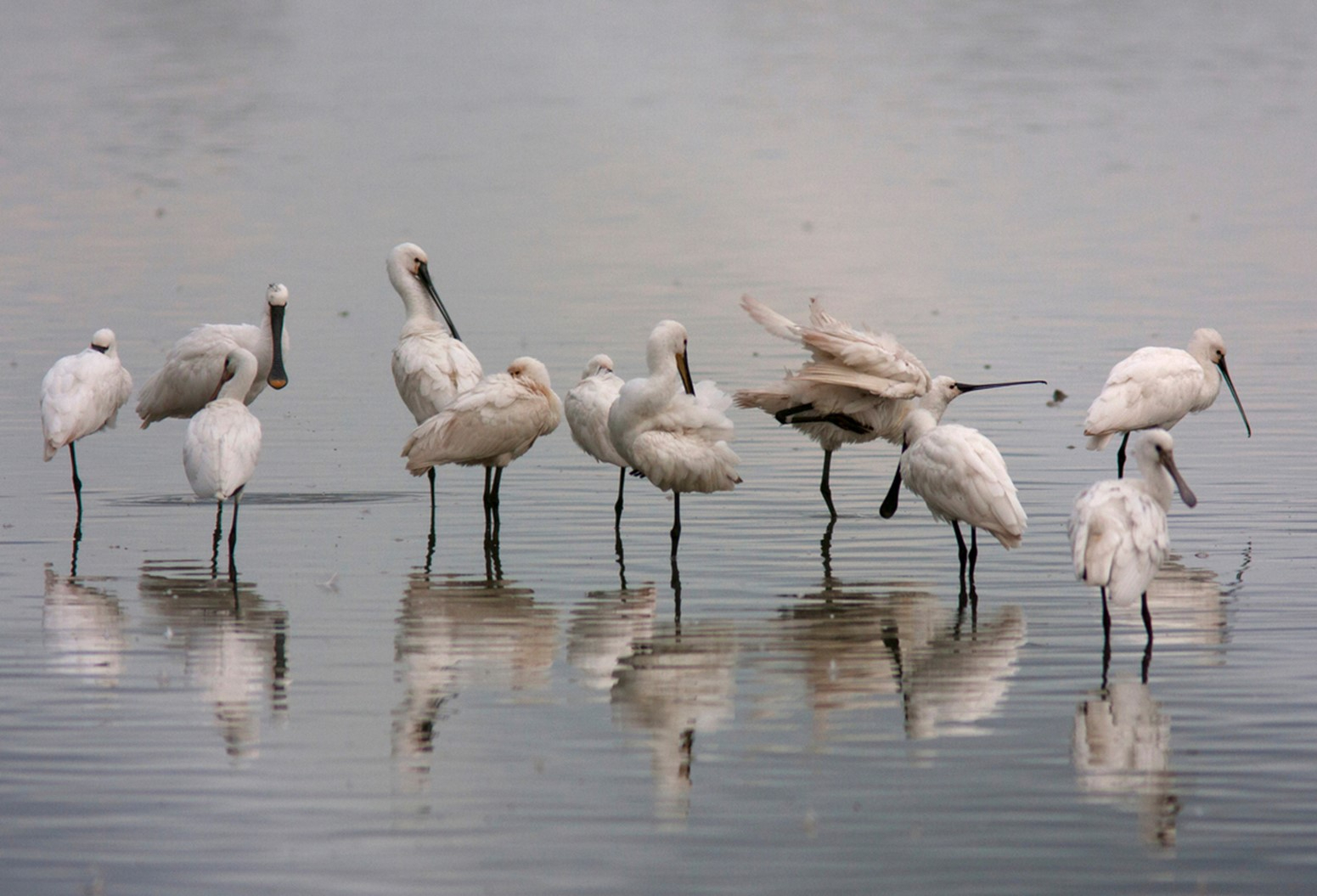
Spoonbill Roeland was the first to depart, on Monday afternoon at 12:00. After a 1.5 hour flight, he stopped at the Haringvliet to spend the night and continued his trip the next day, again in the afternoon. That same day, spoonbill Abel departed at 6:35 from the Oostvaardersplassen. After a non-stop flight of 25 hours (!), Abel has already reached northern Spain and landed at a stopover site frequently used by spoonbills, the Ebro reservoir. Roeland is also going strong and is currently flying along the coast of Vendee in France.
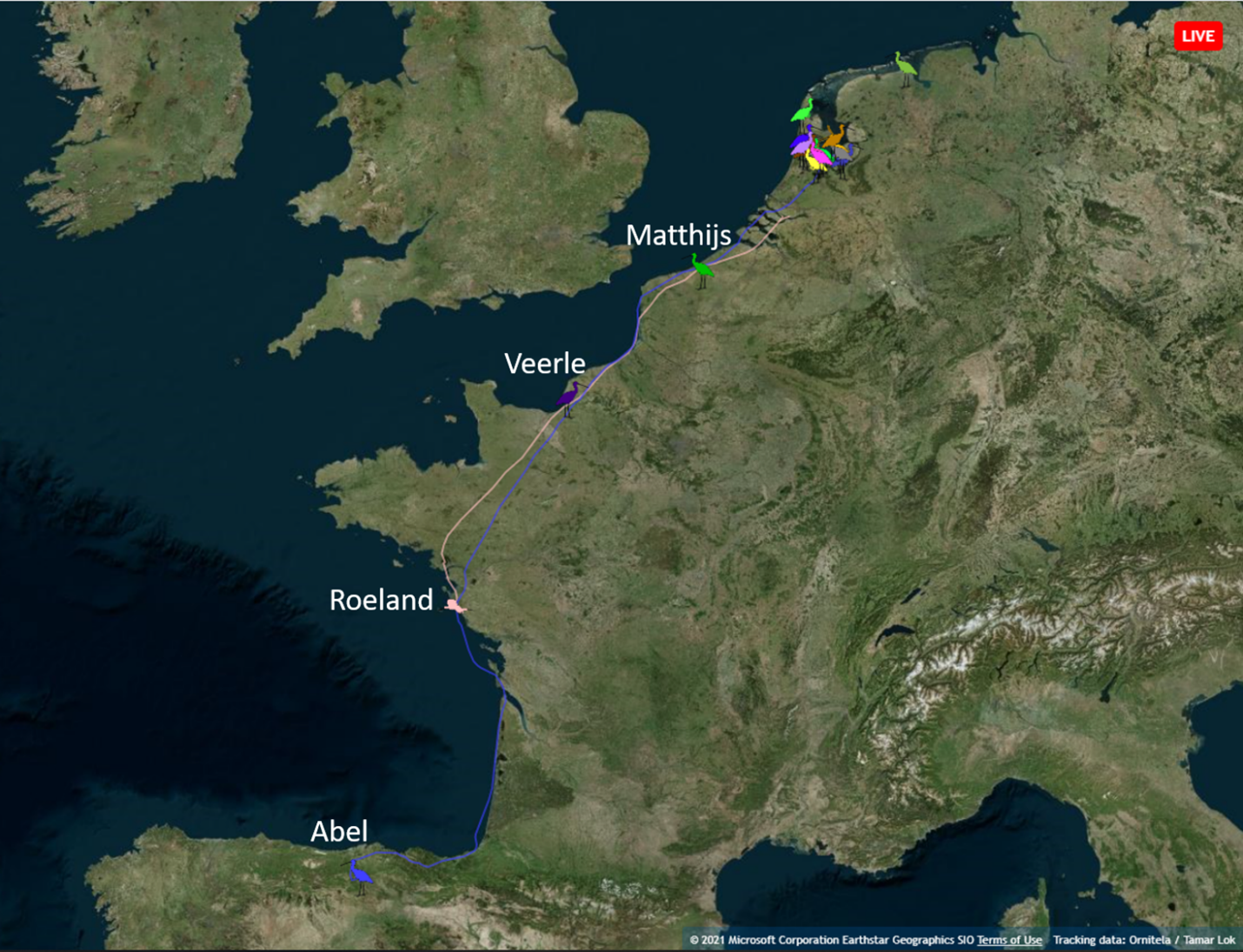
It is probably no coincidence that these two spoonbills, and with them likely many others, departed on two subsequent days. While the wind had been blowing mainly from the west in the past week, weather conditions changed over the weekend. From Sunday evening onward, the wind started blowing from the north, implying a nice wind in the back for birds migrating south. We all know how beneficial a backwind is in terms of saving time and energy when riding a bike. The same holds true, and probably even more, for birds flying in the air. Not surprisingly therefore, many migratory birds have been shown to select days with favourable winds for their timing of departure. Spoonbills seem no exception.
The coming week, the wind is predicted to keep blowing from the north, so more departures can be expected. This means that collecting information about the (social) environment of the birds becomes ever more important. Read here how you can help with this!
12 August 2021 | How does a juvenile spoonbill find its way? You can help answer this question!
By Tamar Lok
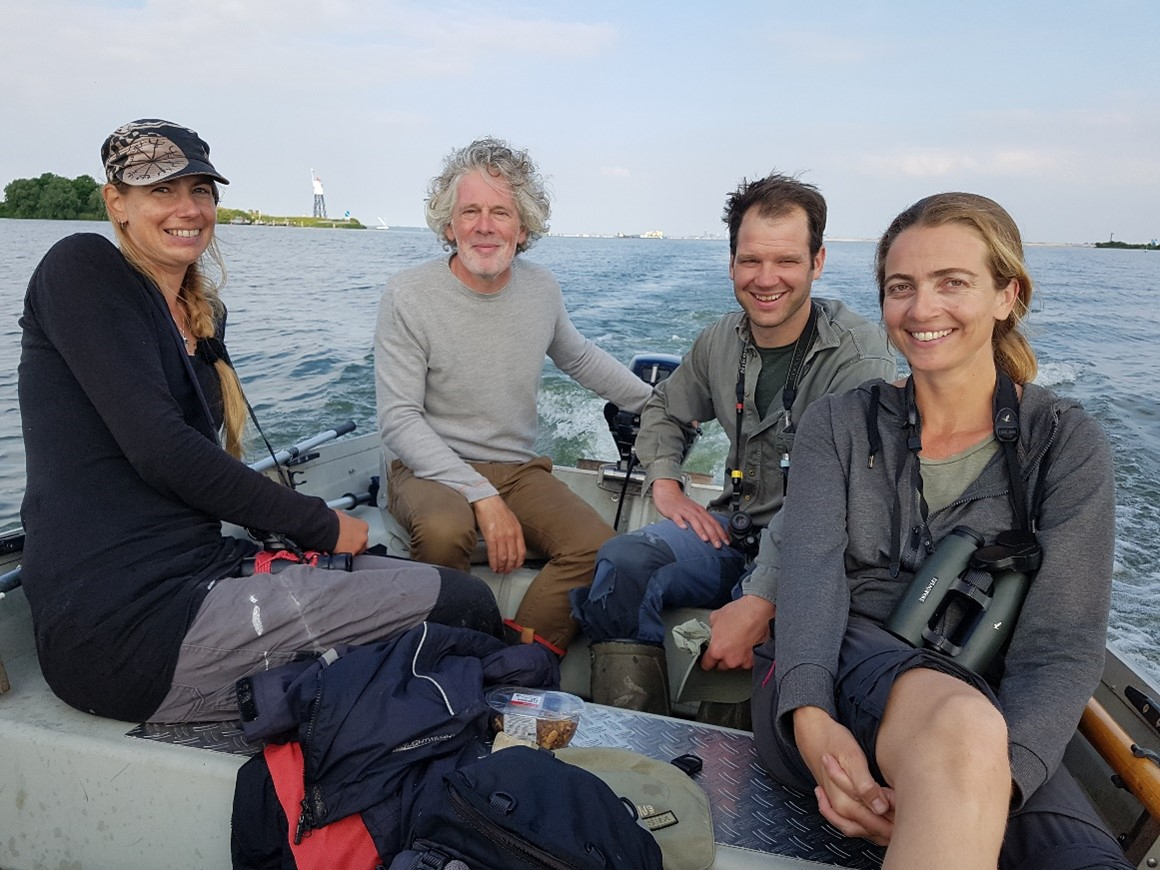
This year, we have equipped 20 juvenile spoonbills with a GPS tracker in the colony on the Hoeckelingsdam near Amsterdam. With around 60 breeding pairs, this is one of the largest freshwater colonies in the Netherlands. Since 2013, spoonbill chicks are being colour-ringed in this colony by the Werkgroep Lepelaar as part of the long-term ringing program of Spoonbills to monitor changes in breeding success and survival over space and time. Yet, in contrast to spoonbills from the Wadden Sea islands, that are known to gather in large numbers (from several hundreds to a thousand) at well-known pre-migratory gathering places such as the Lauwersmeer, the Groninger Kust and the Balgzand, there is a lack of knowledge about which areas are important as post-breeding habitats used for resting, moulting and foraging in preparation for their southward migration for spoonbills from the Hoeckelingsdam and other freshwater colonies.
The 20 transmitted juveniles therefore provide an excellent opportunity to learn more about this, as well as about the environmental factors shaping the routes of their first southward migration. They received their transmitter in June, at the time they were fully grown and almost able to fly.
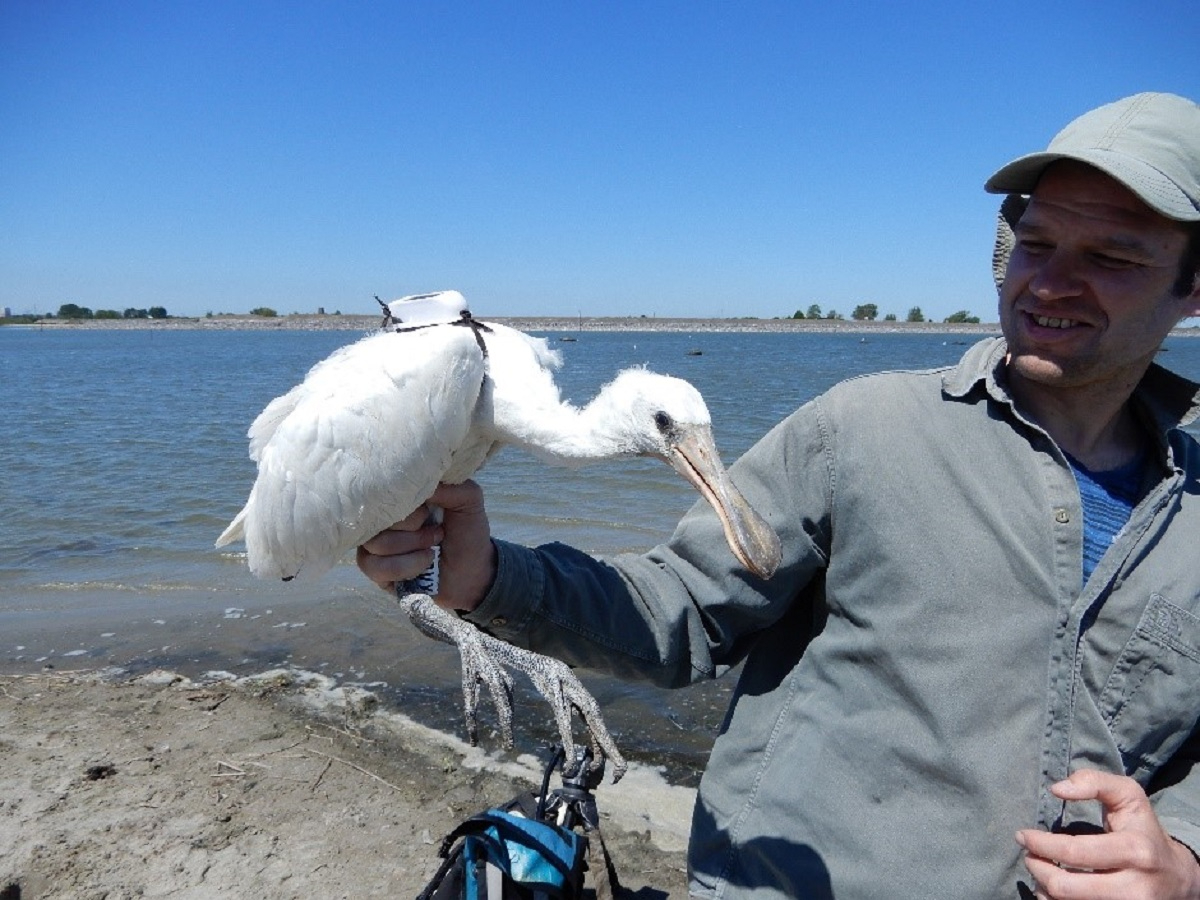
By now, all transmitted juveniles have left the colony and dispersed to other sites, to several sites across Noord-Holland, where they show a strong preference to nature reserves, and to the Oostvaardersplassen. Most juveniles are very faithful to a single site, where they have been hanging around since they fledged from the colony, others are (or better said: have become) very explorative and visit many different sites within a short period.
For example, after having stayed in the Oostvaardersplassen for more than a month, Pippi now started to show explorative movements, travelling northward (against the migratory direction) across Friesland to the Wadden Sea area. Despite having encountered large groups of Spoonbills on Schiermonnikoog and at the Groninger kust, she decided to continue her exploration, now being close to the German border at Zuiderduin. Two other explorers are Thomas, who stayed in Polder Zeevang for a long time, but now moved to the Balgzand area after a short visit to a colony in Den Oever, and Petra who is currently staying near Kampen after having made a nearly complete roundtrip visiting Balgzand, Ameland, the Frisian coast, Sneekermeer. Such explorative movements allow juvenile birds to explore their environment and search for suitable foraging areas and potential breeding sites to return to once they have become mature. Rather than exploring The Netherlands, spoonbill Veerle decided that it was already time to start migrating south! That is very early, at least compared to what we know from the Wadden Sea spoonbills, who usually depart only in September. But French colleagues from the “Maison de l’estuaire” confirmed that she was not the only one, as they observed her on 10 August in the Seine estuary in a group of 86 other spoonbills. So the migratory season has already started!
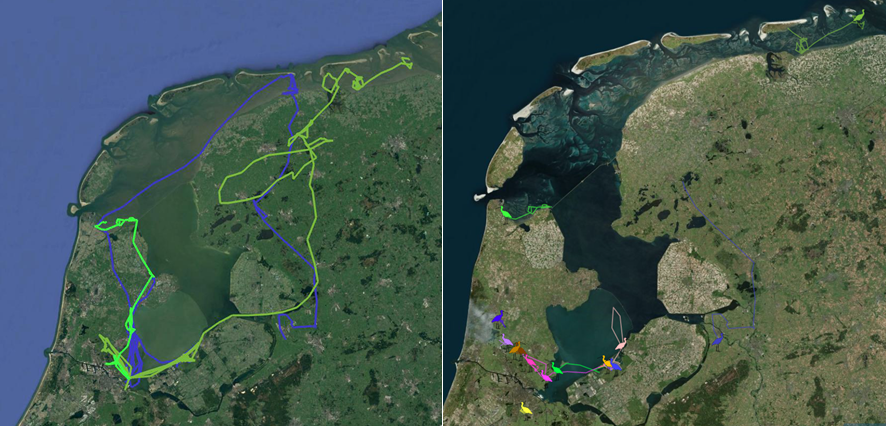
In addition to a better understanding of the post-fledging habitat use of spoonbills from the Hoeckelingsdam, the primary goal of this research is to understand the environmental factors shaping the first southward migration routes of these juveniles. We expect that particularly social information (from experienced adults) plays an important role in driving stopover and winter site choice of young spoonbills. To investigate this further, we would like to collect information about the (social) environment that the GPS-tracked juveniles find themselves in. This allows us to investigate whether juveniles that were in the presence of experienced adult spoonbills adopt more suitable migration routes and have higher chances to survive, and whether they establish “social bonds” that are maintained during migration. The latter can only be confirmed when there are other colour-ringed individuals in the group. To collect the required information, we would like to ask the help of citizen scientists.
How can you help?
If you see a spoonbill with a transmitter on its back, we would be very happy if you could try to collect (some) information about its environment. You can find the most recent locations of the birds (over the past 24 hours) on this website, or on the Animal Tracker app. Please go to ‘We need your help’ to read what information we are particularly interested in and how you can send this information to us.
Your help is greatly appreciated!